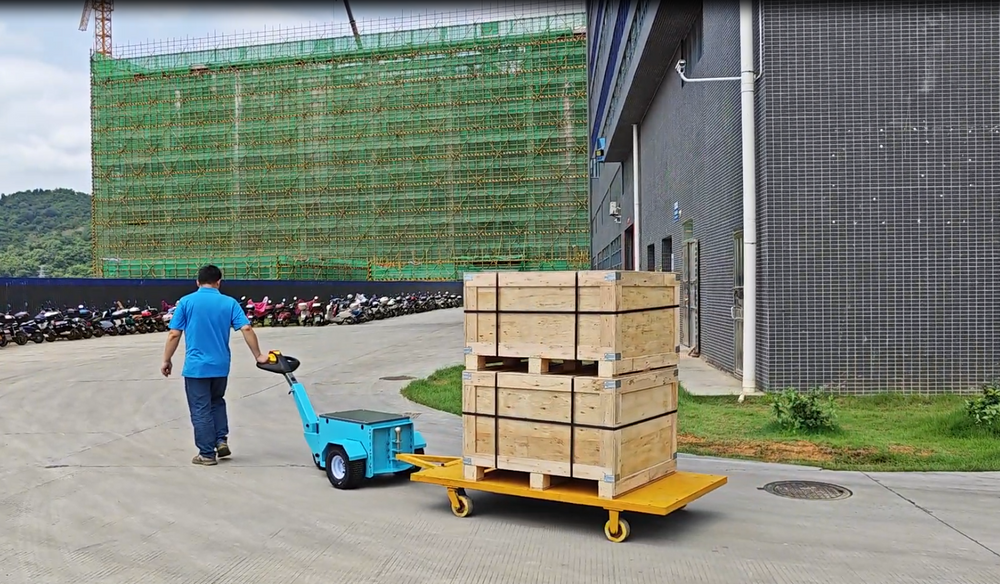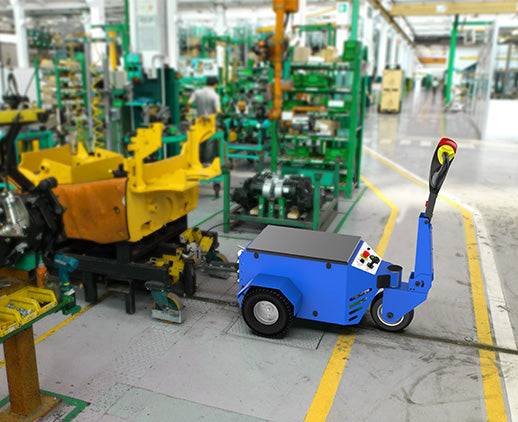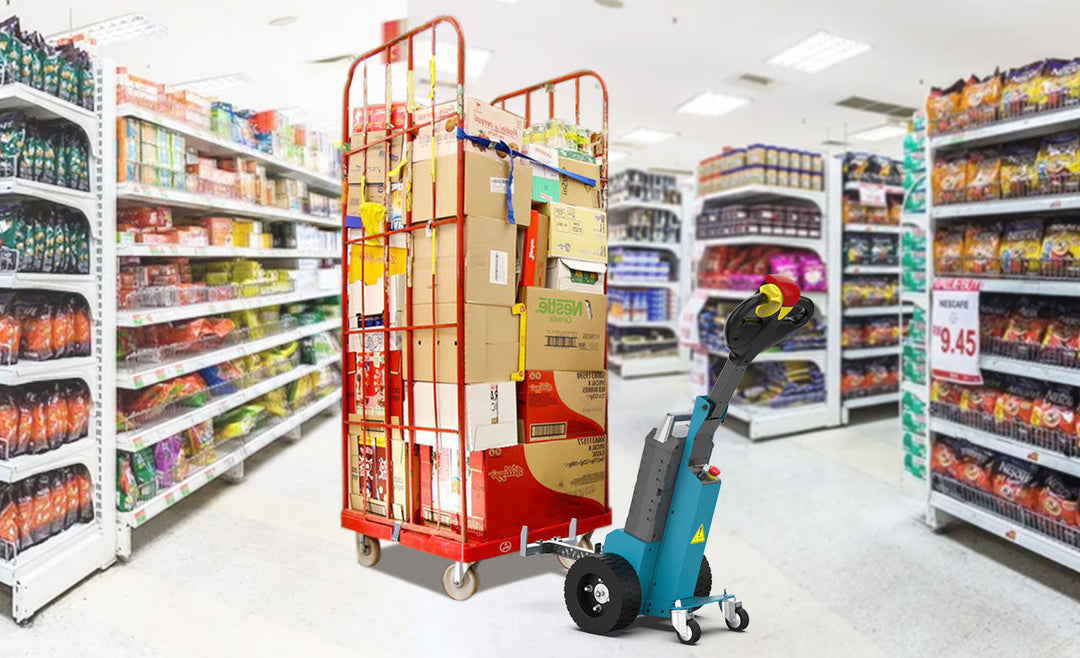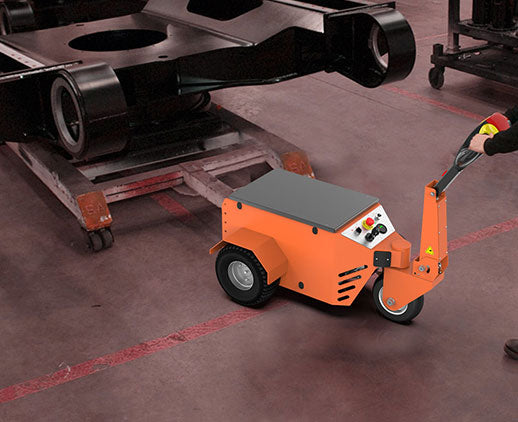What is a power tug?
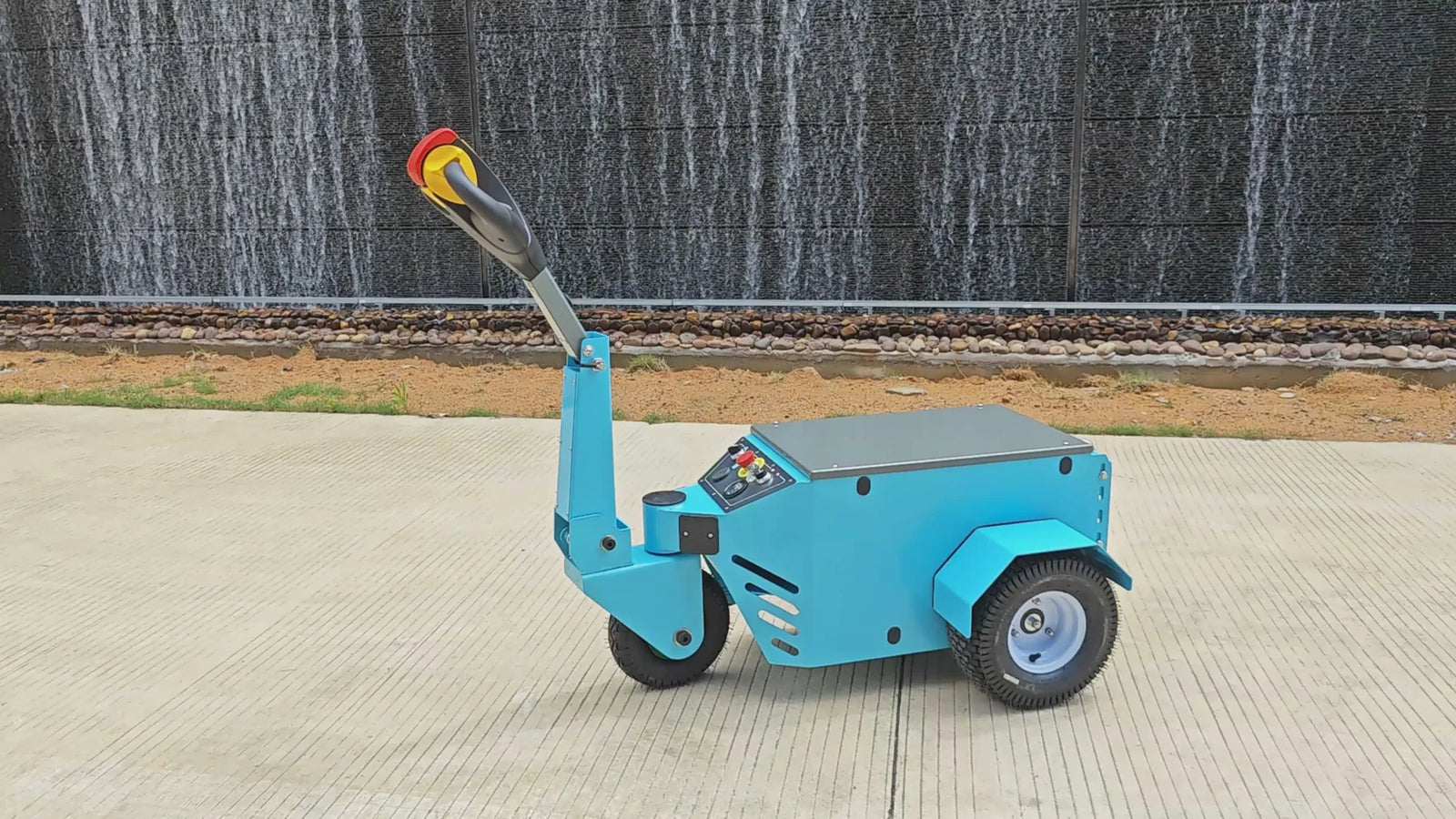

Definition
A power tug is not just a piece of machinery but a vital solution to industries that require efficient material handling. This is because power tugs reduce manual handling injuries by up to 70%, lowering company insurance costs and compensation claims in return. In a warehouse, for example, the average claim for an injury from a lifting incident costs a business $42,000, covering downtime, legal fees, and lost productivity.
Consider airports, for example. An electric tug for aircraft towing can handle loads of up to 40,000 lbs 18,143 kg. Assuming that an airport has planes landing and taking off every few minutes, saving even five minutes per aircraft movement will result in annual savings of millions of dollars. This is why major firms like Lufthansa Technik have heavily invested in their fleet renewal with lithium-powered ride-on tugs that have a 10-year battery lifetime with up to 500 towing cycles per charge.
In retail and distribution centers, pedestrian-operated power tugs can move carts and pallets weighing over 5,000 lbs (2,268 kg), and they do so at an average walking speed of 3 mph (4.8 km/h). That may not sound fast, but consider this: an unassisted worker would typically move the same load at 1 mph (1.6 km/h) or less due to the sheer physical effort required. Over the course of an eight-hour shift, that speed difference can mean an additional 2.5 miles (4 km) of material movement per employee, leading to faster order fulfillment and reduced backlogs. Amazon, for example, introduced power tugs across its fulfillment centers in 2018 and reported a 15% increase in efficiency within the first year.
One major concern companies have when considering power tugs is cost. The prices for a power tug can begin anywhere from $5,000 and scale way up to $50,000 depending on the capacity, type of battery, and inclusions such as automatic braking system, variable speed control, and safety alarms. It is a huge investment, but companies that do a cost-benefit analysis find the payback period surprisingly short. For instance, a manufacturing plant producing heavy machinery might spend $30,000 for a power tug but save $12,000 a year in labor costs because it needs fewer workers to move equipment around. That's a 2.5-year ROI-a figure that most CFOs would look on as highly favorable.
There is also the issue of environmental impact. Traditional gas-powered tugs emit upwards of 8.9 kg of CO₂ per hour, while electric models do not emit anything directly. In a 2022 report, the International Council on Clean Transportation found that replacing all electric tugs within the main ports in Europe could shave off as much as 120,000 metric tons of CO₂ annually. This is a number equal to taking 26,000 cars off the road each year.
So, why don't all firms use power tugs yet? Most often, the reason is simply a lack of awareness or resistance to change. In fact, in an industry survey conducted by Material Handling Network in 2024, 68% of the respondents planned to invest in power tugs or similar equipment in the next 12 months, citing increased efficiency, reduced labor costs, and improved workplace safety as their primary motivators.
Of course, there are challenges in maintaining power tugs-particularly with regards to battery management. A lead-acid battery will typically last 1,500 charging cycles, or three to five years of use. The lithium-ion models can support up to 4,000 cycles. They also charge more quickly, often in less than two hours, compared to eight hours for lead-acid batteries. Imagine a warehouse working three shifts a day-with traditional batteries, you'd have to account for eight hours of charging downtime, while with lithium-ion technology, it's near-continuous use.
Notably, a variety of fail-safes exist on power tugs in the aspect of safety. Anti-crush devices, horn systems, and improved visibility due to LED lighting have many models meeting ISO 3691-1 standards for safety. Actually, in those studies presented, injury rates were seen to be up to 50% less at workplaces making use of powered tugs; thus, the OSHA-published case study reflects that.
Types
In fact, by function, power source, and application, among many other factors, they are further classified into various types. While the pedestrian-operated power tugs remain common in retail and healthcare sectors, a ride-on will serve larger industrial sites better. Electric power tugs had a 65% share of the global tug market, MarketsandMarkets reported in 2023, with an estimated annual growth rate of 7.8%, while logistics and aviation industries drive demand higher.
The most common are the electric pedestrian-operated power tugs. Different models serve from 500 kg up to 6,000 kg and work best on negotiating narrow aisles and confined areas; therefore they suit very well hospitals and warehouses. They prove themselves well by decreasing a staggering 40 percent of all the manual handling injuries within a couple of years when deployed at a UK Health and Safety Executive's insistence at all state-funded UK hospitals. These would normally include variable speed controls in the range of 0.5-6 km/h.
By contrast, the ride-on power tugs are designed to move really massive loads that can be over 40,000 kg. The units are usually seen in aviation, shipyards, and other manufacturing installations with space dimensions that are really extra-large. For example, consider Boeing's Everett Factory, the world's largest building by volume, with 4.3 million square meters of floor space, moving aircraft components using ride-on power tugs. A single ride-on tug in this facility can tow loads weighing up to 75,000 lbs (34,000 kg) at speeds of 10 mph (16 km/h), significantly reducing transport times.
Another popular type is the towbarless tug, which is very common in airports where aircraft are being towed. Whereas traditional tugs attach to the nose wheel by means of a towbar, towbarless models clamp directly onto the wheel, thus reducing set-up times by anything from 30% to 50%. This way, turnarounds have started to get much quicker, and time is of essence for the aviation world, where any sort of delays may cost the airlines $62 every minute, says IATA, International Air Transport Association. The possibility of any incident occurring with a towbar, which is 17% of the ground damage cases in airports, is reduced further by towbarless tugs.
Some of the power tugs come fitted with automatic guidance systems (AGS), making them semi-autonomous machines. These tugs use sensors, cameras, and GPS to make their way through complicated environments without interference from humans. These AGS-equipped tugs find increasing applications in automotive manufacturing plants, where precision and timing are of essence. For example, Toyota's production line in Japan has implemented AGS power tugs that deliver parts directly to the assembly stations with millimeter-level accuracy.
Hybrid power tugs: internal combustion engines combined with electric motors. The hybrid tug seems to have it all: the power and long range of a conventional engine, combined with the environmental cleanliness and silence of an electric drive. They find their application in a great number of ports and container terminals, where huge loads are hauled for distances to several kilometers. A 2022 study by the Port Equipment Manufacturers Association estimated that hybrid tugs could reduce fuel consumption by as high as 30%, saving $15,000 to $25,000 annually per unit.
The robotic tug is relatively new in the market but bound to revolutionize warehouse and distribution center operations. Already, companies such as Amazon and Walmart have invested highly in robotic tugs. According to the report of LogisticsIQ, published in 2024, robotic tugs have the capability of increasing order fulfillment rates up to 40% while reducing labor costs by 25% to 30%. The initial investment in robotic tugs is steep, however, ranging in price from $60,000 to $150,000 per unit.
Core Components
At the heart of every power tug is the motor, which determines the machine’s power output, efficiency, and load capacity. For example, a typical electric tug motor ranges from 500W to 3,000W. High-performance motors can generate up to 4,000 RPM (revolutions per minute), allowing the tug to move loads of up to 40,000 lbs (18,143 kg) with ease. The type of motor used—whether AC or DC—affects energy consumption, torque, and overall durability.
Modern electric tugs commonly use lithium-ion batteries, lasting 3,000 to 4,000 charge cycles compared to lead-acid batteries that last around 500 to 1,500 cycles. Lithium-ion batteries have higher energy density, meaning they can store more power in a smaller size. For instance, a 48V lithium-ion battery with a capacity of 100Ah can provide 4.8 kWh of energy, which is enough to keep a tug running for 8 to 12 hours on a single charge. This is very important for industries operating 24/7, where any kind of downtime should be at a minimum. A fully charged lithium battery can be swapped in less than 5 minutes to keep the operation running.
Most power tugs come with variable speed controls that allow the operator to set the speed from 0.5 km/h up to 8 km/h, depending on the load and terrain. A number of these also include programmable speed limits simply to prevent accidents in crowded environments. As such, in hospitals, where sensitive equipment needs to be moved, tugs are often limited to walking speeds of 3 km/h simply to make sure that no patient or staff member gets in harm's way.
It is the hitching mechanism, one of the most important yet overlooked components of all; hitching mechanisms include manual hitches, automatic couplers, and custom adapters. In the automotive industry, for example, power tugs are deployed in hauling vehicle chassis weighing as much as 15,000 lbs (6,800 kg); hence, automatic hitch systems are preferred since they reduce coupling time by as much as 50%, according to a study by Automotive Logistics Magazine.
Most power tugs are of steel frame construction and can support tensile stresses up to 60,000 psi. Other manufacturers use aluminum or composite materials to reduce weight without sacrificing structural integrity. A typical pedestrian-operated power tug weighs in the range of 100 to 200 kg, while larger versions of ride-on weigh over 1,000 kg. The design of the frame should provide equal distribution of weight to avoid tipping over or being unstable, especially when dealing with uneven loads and ramps. According to a 2023 study by the Material Handling Institute, tugs with reinforced frames experienced 30% fewer breakdowns over a five-year period compared to those with standard frames.
Another critical factor in the performance of a power tug is the wheel and tire system. For indoor applications, solid rubber tires are commonly used, while for outdoor or rough-terrain use, pneumatic tires with deep treads offer better traction and shock absorption. A power tug fitted with 16-inch pneumatic tires can handle inclines of up to 10% and navigate over gravel or uneven surfaces without losing grip. Maintenance costs for tires range from $200 to $500 annually.
Advantages of Using a Power Tug
The same OSHA study estimated that manual handling injuries comprise over 33% of all workplace incidents and cost businesses an average of $42,000 per injury. This would involve the integration of a power tug into daily operations, thus allowing companies to reduce workplace injuries by as much as 70% and thereby have a direct impact on productivity and bottom-line profitability. A single worker can perform tasks that would have otherwise required four workers to share, therefore taking up to 75% fewer labor hours per task.
Electric power tugs use about $0.12 of electricity per hour, whereas gas-powered tugs can use up to $2.50 of fuel per hour. This can save a business around $5,000 to $10,000 per unit in energy costs alone over the period of a year. Companies moving from manual handling to power tugs see a return on investment within 18 months; some companies have reported returns of up to 300% over a five-year period.
Each saved 10 minutes on the ground can save an airline over $1 million annually since, according to IATA, airlines lose $62 for every minute an aircraft is late.
Traditional manual handling involves a push and/or pull of over 50 kg load that may cause MSDs. In contrast, with hardly any effort from an operator, a power tug manages to move up to 40,000 lbs (18,143 kg).
In retail environments, where average store sizes exceed 50,000 square feet (4,645 square meters), power tugs help employees move shopping carts, displays, and stock quickly and efficiently. According to one major retailer, the use of power tugs reduced restocking time by 20%, freeing up staff to spend more time assisting customers. Back injuries among staff were reduced by 60% over three years, with the hospital saving over $500,000 in compensation costs.
Load Capacity
The load capability of power tugs normally ranges between 500 kg and over 45,000 kg. The load capacity for electric tugs manipulated by pedestrians working in retailing or hospitals would be up to 5,000 kg, which translates to moving the equivalent of 125 hospital beds at one go. Large, heavy-duty ride-on tugs used in industries such as aviation or shipbuilding can tow loads over 40,000 kg—enough to move a fully loaded aircraft or a container trailer.
In a study undertaken by Material Handling Industry (MHI) in 2024, it was found that companies using power tugs with a load capacity of 2,500 kg to 5,000 kg had material handling efficiency increased by 35% compared to manual handling.
Towbarless tugs are the most common type of tug used at airports, and they can handle aircraft with maximum takeoff weights of up to 100,000 kg. According to IATA, the use of towbarless tugs reduces aircraft turnaround times by an average of 8 minutes per flight, saving airlines up to $400,000 annually for a fleet of 50 aircraft.
The load-carrying capacity of power tugs is also essential to the manufacturing industries. For example, car manufacturing plants use power tugs when moving car chassis weighing between 1,500 kg and 3,000 kg. For example, one operator using a 5,000-kg capacity power tug can move two or three chassis at one time, reducing the number of trips and increasing efficiency along an assembly line by up to 20%.
A power tug with a load capacity of 10,000 kg can move heavy steel beams or big concrete slabs. Regarding the load capacity, one must consider the kind of terrain and conditions under which the power tug shall operate. For instance, in ports and shipping yards, power tugs commonly have to move shipping containers weighing 20,000 kg or more over uneven surfaces. According to a study by the Port Equipment Manufacturers Association in 2022, the use of power tugs with a load capacity of 25,000 kg or more increased the efficiency of cargo handling by 18%, thus enabling the processing of an additional 150,000 containers annually by the ports.
Battery System
In fact, over 70% of new power tugs sold in 2024 have lithium-ion batteries because of their unparalleled performance and up to 10-year lifespan. Traditional lead-acid batteries only last 3 to 5 years and need to be maintained more often. This difference in longevity alone can save businesses $5,000 to $10,000 per unit in battery replacement and downtime costs over the life of the tug.
For example, a 48V lithium-ion battery with a capacity rating of 200Ah can provide 9.6 kWh of energy, enough to operate a power tug continuously for 8 to 12 hours. A 48V lead-acid battery of equivalent size could manage only about 70% as many hours because the energy is partly lost as internal resistance generates heat. This can be especially important in a 24/7 warehouse operation, as one lost hour of productivity could cost as much as $1,500.
Where the lithium-ion batteries take 2 to 4 hours to get fully charged, it takes 8 to 10 hours in the case of lead-acid batteries.
While lithium-ion batteries are roughly $1,000 to $2,500 more per unit at the front end, they pay for themselves over time. In contrast, lead-acid batteries require regular maintenance like refilling water, checking corrosion, and equalization charges that add up to $500 to $1,000 annually in labor costs.
The environmental comparison shows that lithium-ion batteries are greener. They have a 90% charge efficiency, which means that only 10% energy is wasted during charging, while for lead-acid batteries the efficiency is only about 60-70%. For a warehouse running 10 power tugs for 12 hours a day, switching to lithium-ion batteries could save from $2,000 to $4,000 annually in electricity costs.
Where the design for lithium-ion batteries is inherently provided with an internal BMS, regulating voltage, temperature, and current input to prevent overcharging, overheating, and short circuits, lead-acid batteries are generally much more susceptible to thermal runaway. In fact, a 2022 report from the National Fire Protection Association showed 45% of the forklift fires in the U.S. were related to improper handling of lead-acid batteries.
A tug with a 48V 150Ah lithium-ion battery can pull loads up to 10,000 kg on flat and keep performance on slopes up to 15%, while a lead-acid-powered tug may have a 20% performance reduction on slopes because of voltage drops under load.
Another area in which lithium-ion batteries excel is temperature performance. Operating in a wide temperature range from -20°C to 60°C, lead-acid batteries suffered great capacity loss in extreme temperatures. For example, at -10°C, a lead-acid battery may lose up to 50% of its capacity, while a lithium-ion battery retains over 80% of its capacity.
Purchase vs. Rental
A new electric power tug can cost anything from $10,000 to $50,000, a 2023 study by Material Handling Industry (MHI) suggests, which would have an ROI within 18 to 24 months. Conversely, rentals, about $800 to $1,500 monthly, could suit a small or seasonal job much better.
For example, take the case of a logistics warehouse. Assuming that the warehouse is moving 15,000 lbs of goods daily, a power tug should work for about 8 to 10 hours daily. Assuming that the rent costs $1,200 a month, this means an annual cost of $14,400. At this rate, assuming the same warehouse bought a power tug at a value of $30,000, it would take them close to 25 months to break even.
Annual maintenance costs of power tugs vary from $1,000 to $3,000 with a variation in battery type and intensity of use. Replacing the batteries will cost between $1,500 and $4,000.
One big plus in buying a power tug is customization. For example, an airport ground handling company may need a tug to be towbarless for a range of aircraft sizes. Rental units are usually standard models and may not be suitable for specialized tasks.
Buying requires a huge upfront investment, which may not be within the reach of small businesses or startups. Rental offers an immediate solution without it. In a 2024 survey conducted by Deloitte, 45% of small and medium-sized enterprises reported cash flow management as one of the main reasons for choosing rental options over buying.




